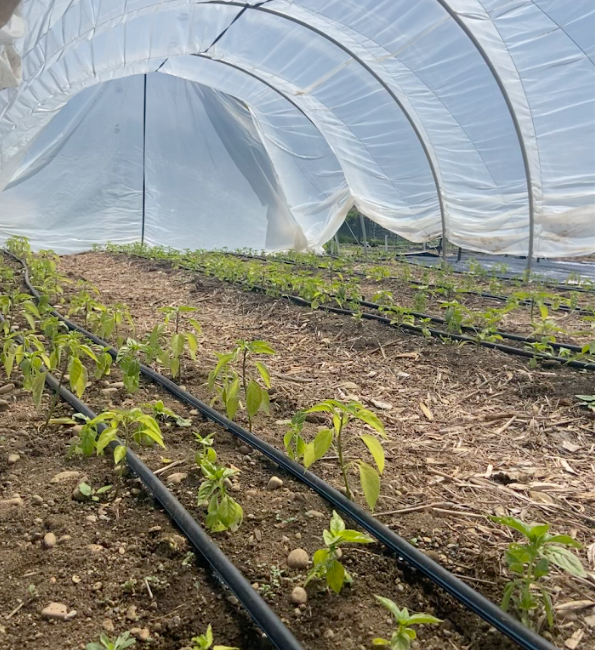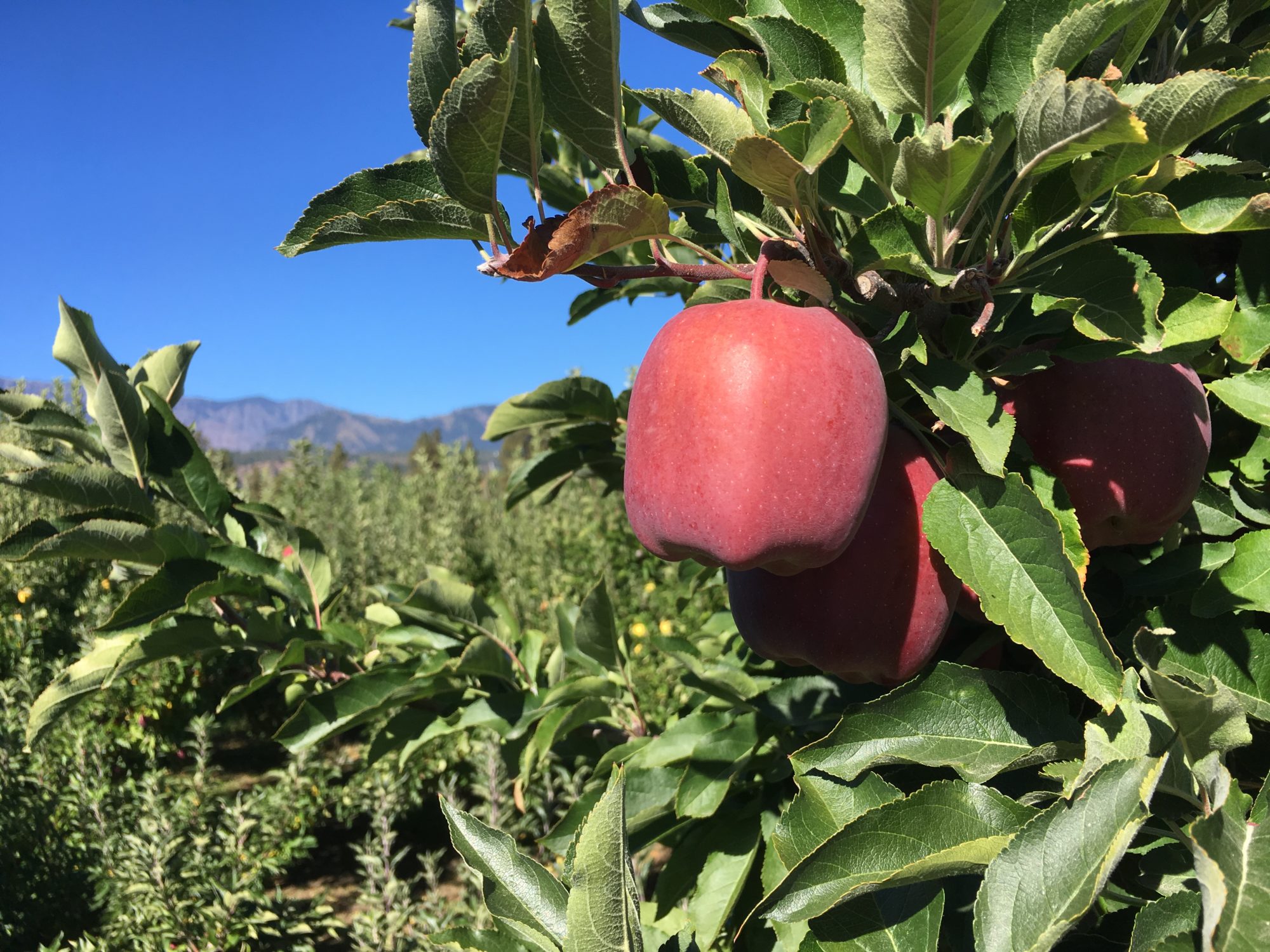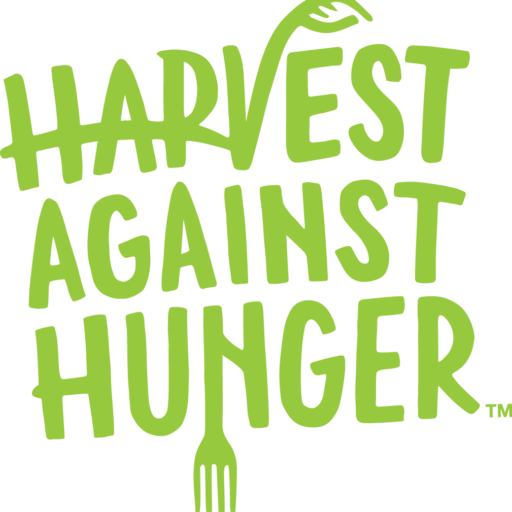
Experimental Crops Interview with Maria at Elk Run Farm
12 Aug 2022, by Admin in Harvest Blog, Elk Run Farm, Harvest Summer AssociateRhianna Costiloe (pronouns: Rhianna/They/She/We) is Elk Run Farm’s AmeriCorps Summer VISTA Associate Service Member through the Harvest VISTA program. They’re at Elk Run Farm for 10 weeks, during the farm’s peak harvest season, alongside five high school students in the Summer Internship program. Together this group gets to learn about critical aspects of the farm that support it in supplying produce to the local food banks. We have each demonstrated a wish to further develop our horticulture skills, understand the workings of what it takes to be involved with a nonprofit farm, and how to be activists for food justice.
Maria Anderson (She/Her) is the Farm Manager at Elk Run Farm who also takes the position of Harvest Summer Associate Supervisor for the Harvest VISTA program at Harvest Against Hunger and Elk Run Farm.
Rhianna: Hi everyone this is Rhianna, I’m the AmeriCorps Summer Vista service member at Elk Run Farm in Maple Valley, WA, for 10 weeks in 2022. I’m here today with Maria Anderson, Elk Run Farm’s Farm Manager. Hi Maria.
Maria: Hi.
Rhianna: So today we’re talking about experimental beds and experimental crops. So can you share with us first your elevator speech of Elk Run farms?
Maria: Sure, yeah, so about seven years ago, a golf course in suburban Maple Valley closed down so that they could build a high school on half of it, and the owners offered about 5 acres of the rest of the golf course to a local coalition of 12 food banks to start a farm and specifically grow produce for the Food Banks.
Rhianna: Amazing! So when the farm was first started, what were the Crops chosen to plant and was that based on anything, maybe typical for Pacific Northwestern climate or landscape? Or maybe what food pantries were used to receiving, etc.?
Maria: Yeah, so we broke ground in October or first year and we really only had one option for the very first crop that we could plant, so we planted garlic. which is something that you plant in the fall in the Pacific Northwest over winter and then harvest the next early summer. And, so that was an easy one. All the food banks when we were talking about what we were going to start growing said that garlic was not something that was available for the most part in their food banks. It was not something they got through their regular donation streams and that when they did have it, everybody wanted it. So that was an easy crop for us to start with. Worked with the timing. We also didn’t have irrigation at the time and the seasonal sort of water in the Pacific Northwest is well suited to garlic growing ’cause by the time it starts drying out in the summertime, the garlic wants to dry down anyway. Aside from that, we talked to food bank directors a bit about what produce they might want to see. And having farmed in the Pacific Northwest for a couple years, prior to starting Elk Run, I had a sense of what was going to grow effectively here and not, so things like kale and cabbage and collards grow really easily for the most part. In our climate, the Pacific Northwest is known for brassica production. So that was easy, sort of low hanging fruit. And then I mean easy, relatively easy sort of gardening vegetables like summer squash. It’s really hard to mess up summer squash. And gradually sort of branching out more and more. From there we probably grew 25 to 30 different crops. Our very first year and now we’re up to over 50 different fruits and vegetables and herbs on the farm.
Rhianna:
Wow, and so when did you start having what would you consider experimental beds and experimental crops?
Maria:
I think we officially set aside 5 beds on the edge of the field three seasons ago, so this is our third season with a sort of designated space to try new crops. But the idea behind experimental crops was something that we tried every single year. In part because it’s fun and it keeps things exciting on the farm for staff and for volunteers to be trying new things and rotating them in. But we really we wanted to reduce the number of sort of wild card things we had growing in the field. To make sure we were really maximizing the space that we have to grow as much really desirable food as possible for folks. So, rather than having it sort of Willy Nilly in the field wherever we could find room for it, setting aside a specific space meant we make a whole farm plan for the rest of the field. Based on varieties and vegetables we know are going to be successful and then we can have the freedom to try new things that might fail in this space that we have specifically set aside for it.
Rhianna:
And how do you choose what will go into these experimental crops? Are they surveys or maybe cultural considerations?
Maria:
Yeah, we definitely have some cultural considerations that we’re bringing into it. We have a lot of folks from all over the world that have a lot of different culinary traditions using our food banks. So we’re we’re looking for ingredients that are less prevalent in our area, harder to find. That are really going to be some of those things that make people feel like at home, that feel comfortable, that feel like they can make the foods they really want to give their families. We haven’t done as much surveying as we want, although we did do an initial survey of 10 of the food banks. We have something like 400 responses from food bank customers. We had planned to do a whole other round of surveying in 2020 and I think we all know how that went. So, we don’t have super recent data that we were hoping to have, but we are in constant contact with food bank directors and volunteers. We’re getting feedback from them about what they already have and how we can sort of fill gaps. And in part, like we have a couple seed companies we really love. We’re getting their catalogs and we’re seeing what new crops they’re growing too, because they’re like the seed companies are also responsive in this kind of way. As there’s more like culturally appropriate food being demanded in the food banks, it’s also being demanded at the farmers market and at the grocery store like there’s just more, there’s more economic demand for these things so seed companies that might have been growing more like traditionally American vegetables are now sourcing seeds and growing different varieties of Asian vegetables and African vegetables, and you know things that five years ago I had never heard of and now I know how to grow, in part because they’re doing some of that work to making those seeds available. Figuring out what the sort of recommendations are for different vegetables in different regions as well as there’s a whole bunch of smaller seed companies that specialize in cultural, like different cultural food. One of the seed companies we buy from is like a Japanese seed company based out of California, where we’re getting a lot of specialty Asian vegetable seeds that are not available anywhere else.
Rhianna: And So what are on the in these experimental beds this season?
Maria: So this season we have Ethiopian Kale, which is a kind of mustard. We have fennel which we tried in the early years of the farm like years one and two, and it just I’d never grown it before, it didn’t work very well at all, so we’re trying again with more knowledge. We have yardlong beans, which are an Asian green bean. That usually that one sort of on the fence for us. It needs more heat than we can reasonably give it in the Pacific Northwest so it was a bit of a gamble to try to plant it and see. The plants themselves are thriving right now. I don’t know that the summer is going to be hot and long enough for it to get very much to maturity, we’ll see. That’s part of the nature of the experimental beds. We have wax boards which are a follow up to bitter melons that we grew in those beds last year. The bitter melons were really successful, enjoyed growing those a lot. People were very excited about them, so we’re trying another sort of Asian melon gourd vegetable. One more. I can’t remember what the 5th one is off the top of my head.
Rhianna: That’s alright. And so how will it be determined if these will graduate into being made consistent crop for you?
Maria: So usually it is did we get enough value, so like one of the things that we’re tracking every year is how many pounds of a vegetable were harvested per bed foot that we planted. So we have like numerical standards that we’re using to be deciding if it’s a good use of space. So seeing how many pounds per bed foot we’re harvesting of these different crops. That’s not the only one we use, but that’s that’s sort of first round as we look at how productive it actually was. There are a couple, there’s a couple crops we’ve tried more than once that we have officially given up on. One of those is actually soybeans, edamame. I don’t know how people are growing it so successfully at scale because we have tried to growing it at our scale two years in a row and they were both miserable failures and we’re done trying to grow soybeans. But, like bitter melons and parsnips, last year we got good harvests off of them. People were really excited about them. They didn’t require a ton of work from us. That’s another sort of trade off. And so they were successful enough that we added them into the regular rotation.
Rhianna: The poor soybeans though.
Maria: Yeah, I know I was really excited about edamame. Like fresh edamame for people that would be amazing and we could not. I we I don’t think we ever got a plant bigger than two inches, like it was a disaster. Well, I don’t understand to this day what happened with the soybeans though I we gave it a try twice and that’s it.
Rhianna: Do you know off the top of your head how many experimental crops have been graduated?
Maria: I don’t know an exact number. I would say over the last three years of like 15 crops, probably 5 or 6 have gotten added into the regular rotation.
Rhianna: Great yeah and some other, do you know off the top of your head some other things?
Maria: That haven’t worked out other things that haven’t worked out. I should!
Rhianna: Well I guess so how much of what is being grown on Elk Farm has been an experimental crop previously? You kind of mentioned the beginning Everything was kind of experimental.
Maria: Yeah, I. I would say since we consciously started, like separating out experimental crops were probably it’s probably like a tenth to an eighth, maybe of the crops are experimental crops. Mostly what we’re growing are things that are really successful here that staff have grown on other projects before that, you know, sort of tried and true, know are going to be relatively successful for us. Which doesn’t guarantee success, obviously, but you know the cucumbers have never really been an experimental crop. Whether we have a good cucumber year or not. Cucumbers are pretty straightforward and pretty familiar for the farm staff.
Rhianna: And do you have any tips on how someone small or maybe large, maybe medium scale could incorporate experimental crops into their gardens or farms and any that are good ones to start with in the Pacific Northwestern scheme?
Maria: Yeah, I mean I think. One of the things that’s the most inspiring for me is that like, you know, November/December looking at looking at seed catalogs and just like seeing what are the new crops that are coming. Just like poking around things you haven’t looked at before. I get a lot of inspiration to, make a lot of those choices just in that like winter time dreaming mode, so I would just encourage people to like. Maybe deliberately set aside space like we have and pick a couple almost at random like not totally at random, but if it if it seems interesting and you’re not sure if you can pull it off. Why not try it. Pacific Northwest is a relatively short warm season, so anything like full size watermelons, really melons of any kind are tricky here. Even like sweet corn can be tricky here, or anything that needs basically, more than 100 days to maturity, sometimes even more than 90 days to maturity of like nice warm weather is not a guarantee anything more than that here. So definitely looking, looking and understanding your sort of plant families. Like I said, Brassicas do really well here. They don’t mind a frost, so if you have something that takes a little bit longer to get to maturity. You know 120 day Brussels sprout for example is going to be more successful, than 120 day pumpkin. The pumpkin is going to die at the first frost that Brussels sprout is going to get sweet at the first frost, so you know, understanding your plant families and how they respond to different kinds of weather, I think is critical to success. So brassicas do well in the cold weather, not necessarily in the heat, so the heat of the summer, even though it doesn’t last that long it’s still pretty intense here, so try things, but also you know, pay attention to what farmers and gardeners in your area are already growing successfully and it gives critical. If you’re on social media, like find your local farms and follow them, they’re going to be posting stuff about the stuff that’s working for them.
Rhianna: That’s great, thank you and last question. It’s a little of a doozy, I suppose. But how is incorporating experimental crops for you maybe in your opinion, an act of food justice or to support food security?
Maria: I think for us at Elk, Run, the experimental crops have been a place to try to grow things that aren’t as commonly available. The kinds of things that you’re going to find at a specialty market rather than like a more traditional American grocery store like a Safeway or Fred Meyer. And knowing how many people are from culinary traditions that are outside of what is available at those grocery stores in our area it seems like the way forward like I can’t, it doesn’t even make sense to not try to grow as much of that that unique, less available, fruits and vegetables here at the farm. And we’re constantly stretching our growing zone in that way, like we’re trying things that are on the edge of possible because so many of the things that people are really interested in come from hotter, more humid climates. Even like hot Peppers, we grow a lot of hot Peppers, but they’re never hot enough and we never have enough for people, so like we’re trying, but those would be easier to grow somewhere else. That doesn’t mean we’re not going to try to grow them here. So I think that articulates specifically with food justice, in that, you know, we believe that food justice is making it so that people have access to the foods that they want to eat like bottom line. So finding foods from other culinary traditions, figuring out how to grow them, and providing them at the food bank so that everybody who goes to that food bank has access to them. Whether they could afford them at a specialty grocery store or not, is sort of critical to the mission of what we’re doing here at the farm.
Rhianna: I love that. Well, thank you so much for answering all these questions. It’s been really lovely talking with you about this and I can feel your passion for bringing food justice to the surface and you know, seeing how Elk Run Farm is part of that system. So thank you.
Maria: Yeah, you’re very welcome.


